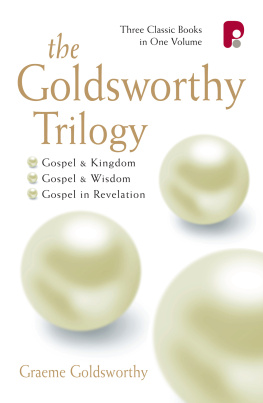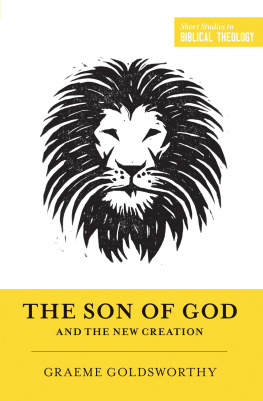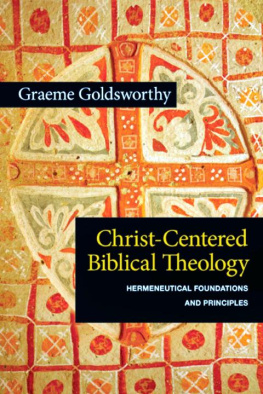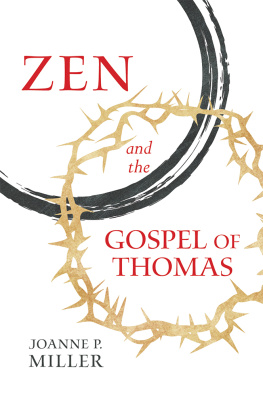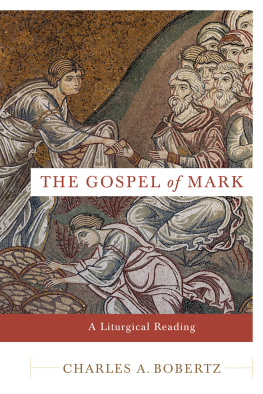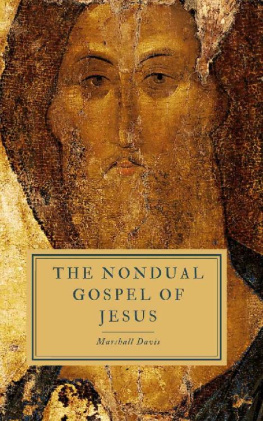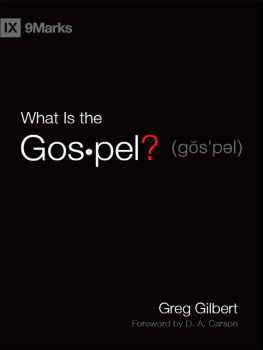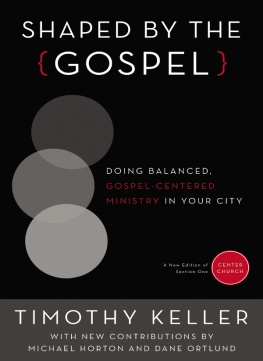THE GOLDSWORTHY TRILOGY
THE
GOLDSWORTHY
TRILOGY
Graeme Goldsworthy

Copyright Graeme Goldsworthy
Gospel and Kingdom 1981
The Gospel in Revelation 1984
Gospel and Wisdom 1987
This trilogy was first published in 2000 by Paternoster
This edition First published in 2011
Paternoster is an imprint of Authentic Media Limited
52 Presley Way, Crownhill, Milton Keynes, MK8 0ES
www.authenticmedia.co.uk
Thirteenth impression 2013
19 18 17 16 15 14 13 19 18 17 16 15 14 13
The right of Graeme Goldsworthy to be identified as the Author of this Work has been asserted by him in accordance with the Copyright, Designs and Patents Act 1988
All rights reserved. No part of this publication may be reproduced, stored in a retrieval system, or transmitted in any form or by any means, electronic, mechanical, photocopying, recording or otherwise, without the prior permission of the publisher or a licence permitting restricted copying. In the UK such licences are issued by the Copyright Licensing Agency,
Saffron House, 610 Kirby Street, London, EC1N 8TS
British Library Cataloguing in Publication Data
A catalogue record for this book is available from the British Library
ISBN 978-1-84227-036-3; 978-1-78078-005-4
Unless otherwise stated, Scripture quotations are taken from the
HOLY BIBLE, NEW INTERNATIONAL VERSION
Copyright 1973, 1978, 1984 by the International Bible Society.
Used by permission of Hodder & Stoughton Limited.
All rights reserved. NIV is a registered trademark of the International Bible Society. UK trademark number 1448790
Design by James Kessell for Scratch the Sky Ltd. (www.scratch-the-sky.com)
Typeset by WestKey Ltd., Falmouth, Cornwall
Contents
Contents
This book has grown out of a deep concern for the recovery of the Old Testament as part of the Christian Bible. It is indisputable that even evangelical Christians demonstrate a neglect of and an ignorance towards the first three quarters of the Bible. We need not reflect here on the cause of this problem, but that it is a problem hardly needs to be stated. One could almost suggest that Bible-believing Christians suffer a bad conscience over this serious lack of understanding of the Bible as a whole and with good reason.
I have often been asked to give a series of studies on the Old Testament by various groups. We havent done anything on the Old Testament for a long time. What about a series on the minor prophets? (The minor prophets seem to have a peculiar fascination for study groups which are ignorant of the Old Testament!) I have usually responded with a counter-proposal that we hold a series of studies on the structure of the Old Testament theology and the unity of the Bible. Not surprisingly, the outcome has usually been an enthusiastic response to anything which helps to show how the various parts of the Bible hang together.
While teaching a course of biblical theology over a number of years at Moore Theological College I found it almost impossible to recommend a single book (of an introductory kind) on the subject. Obviously what was needed was something for the pastor and teacher, as well as for the ordinary Christian, which would give basic principles of Christian interpretation of the Old Testament. The frequent requests by students for recommended books was from time to time replaced by a pointed challenge to undertake my own work for publication based upon the course of lectures given at Moore College.
This little book is the outcome. In writing it I have tried to keep in mind the needs of all those who, with little or no formal training, undertake the task of reading the Bible for their own edification or in order to teach others also. Experience would suggest that pastors and preachers are also in need of help of a fairly uncomplicated and non-technical kind. The risks of over-simplification are very great, but the pressing nature of the task makes such risks worth taking.
I owe a debt of gratitude to my many teachers who have instructed me in biblical and theological studies. I am particularly beholden to Archbishop Donald Robinson for imparting to me some of his enthusiasm for and insights into the study of biblical theology. I am also grateful to those who willingly helped with the typing of the manuscript.
Graeme Goldsworthy
Brisbane
Killed Any Good Giants Lately?
The Sunday school anniversary service has just begun and the hall is packed with children under the watchful eyes of teachers and parents. They all sing lustily with the help of an accordion and a couple of guitars, while the song-leader conducts energetically from the platform. The childrens eagerness for the Bible story soon to be presented is not shared by the young man sitting on the platform and nervously thumbing through his assorted illustrations and flash-cards. Perhaps more thoughtful than most, he is seized by a sudden doubt about the application he intends to make from the Old Testament story he is about to tell. There is nothing wrong with his visual aids, and his storytelling technique is recognized to be of a high standard. There is something which bothers him. How is he to take those far-off events of a thousand years or more before Christ and make them say something to his youthful hearers of the twentieth century?
This uncertainty is not a sudden thing. Let us suppose our friend (call him Ken) is someone who has been brought up in a Christian home and a live, Bible-based church. Over the years he has been well taught the contents of the Bible and has learned a way of applying these to his own Christian existence, assumed to be the only proper way. As a Sunday School teacher he gradually acquired a skill in this kind of application, but was never quite sure of the principles behind the method. But through an interest in biblical studies he began to be aware of the variety in the literature of the Bible as well as of the historical context of its events. Not that he shared the doubts of some of the books he read as to the inspiration of the Bible, but he did become aware of the rather haphazard approach to both the original meaning of the text and to its application to the here-and-now which he previously accepted.
The invitation to speak at the anniversary service has faced Ken with a new problem. He cannot simply rehash the story in accordance with the lesson material of their Sunday School curriculum (not that he was very happy with it anyway!). His uneasiness about the method of telling a Bible story was intensified a couple of weeks previously when he listened to another speaker at a childrens rally present the story of David and Goliath. It had been well done and the children loved it. There had been lots of excitement in the play-acting of that great victory by Gods chosen leader, and the use of visual aids had been carried out with care and precision. But Ken was most troubled by the way the speaker had applied the story. The fellow dressed up as Goliath had progressively revealed a list of childhood sins by peeling cardboard strips off his breastplate one by one, as the speaker explained the kind of Goliaths we all have to meet. Then a strapping young David had appeared on cue, and produced his arsenal a sling labelled faith and five stones listed as obedience, service, Bible reading, prayer and fellowship. The speaker had omitted to say which stone actually killed Goliath, a matter which caused a little mirth when Ken discussed the talk with some friends. But underneath the mirth was a real sense of uneasiness and confusion over the matter of how such an Old Testament story should be applied.
Next page
